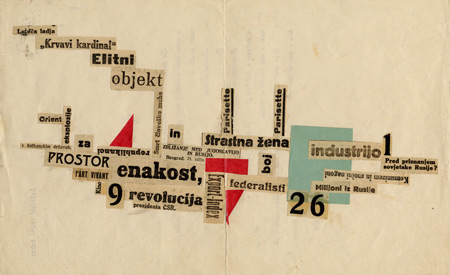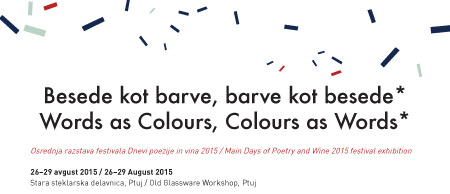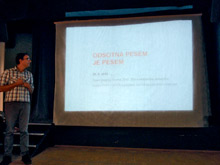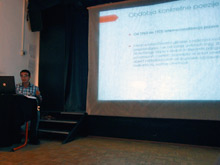PROJECTS | Exhibitions
Words as Colours, Colours as Words*
Main Days of Poetry and Wine 2015 festival exhibition
26–29 August 2015
Old Glassware Workshop, Ptuj
Opening hours: 11 a. m. – 9 p. m.

Srečko Kosovel, Leteča ladja, collage, 1926
(By courtesy of National and University Library of Slovenia, Ljubljana)
Artists: Maja Burja, Avgust Černigoj, Primož Čučnik & Gregor Podlogar & Žiga Kariž, Matjaž Hanžek, Andrej Hočevar & Jaka Železnikar, Alenka Pirman, Srečko Kosovel, Anton Podbevšek, Zoran Srdić Janežič, Valérie Wolf Gang
Curators: Dušan Dovč, Mihael Kelemina, Simona Žvanut
Exhibition design: Vesna Bukovec
Advisor: Saša Nabergoj
Opening: Wednesday, 26 August 2015, at midnight
Lecture: Dušan Dovč, Missing Poem is a Poem,
Saturday, 29 August 2015, at 6 p. m., Old Glassware Workshop
 On behalf of the invitation of Beletrina Academic Press publishing house is Studio 6 team in 2015 preparing two events that examine the relationship between artistic expression in visual arts and in words, and which can be placed among research projects that transcend the boundaries of a single art form. Both events will be part of Days of Poetry and Wine 2015 festival programme. On behalf of the invitation of Beletrina Academic Press publishing house is Studio 6 team in 2015 preparing two events that examine the relationship between artistic expression in visual arts and in words, and which can be placed among research projects that transcend the boundaries of a single art form. Both events will be part of Days of Poetry and Wine 2015 festival programme.
On 24 August 2015, in the framework of the Evenings before the Days, a documentary presentation of the poetry and visual project Ode on Manhattan Avenue (Čučnik, Podlogar, Kariž) was held in the SCCA Project Room (Metelkova 6, Ljubljana). The authors, poet Primož Čučnik and visual artist Žiga Kariž discussed the project with Dušan Dovč, explaining its background, the impulses behind its creation, its conclusion and potential future impact, as well as their great amazement at New York City, where the poetry published in Ode on Manhattan Avenue was created. The discussion in the Project Room will be accompanied by a presentation of conserved documentary materials that were created at a series of readings, as well as by audio-visual recordings made in Ljubljana and on a tour of the United States.
Two days later, on 26 August 2015, we will prepare the main festival exhibition Words as Colours, Colours as Words* in Ptuj's Old Glassware Workshop. Exhibition will be conceptualised by thinking of the festival's poetry programme and events – as well as the city of Ptuj as the host. Authors who have on the one hand searched for visual value in words or on the other hand space for words on the canvas will present themselves. The exhibition will, in three complete sections, offer a selection of quotes from the manifestos of visual and literary artists, which will initiatively lead visitors through the history of experimenting with form and word; it will present artists of the Slovenian avant-garde, a reference for both Slovenian visual and literary creativity; and it will be concluded with artistic works and multimedia installations by contemporary artists.
On Saturday, 29 August, at 18.00, when the festival draws to an end and the exhibition closes its doors, Dušan Dovč will hold a lecture Missing Poem is a Poem on visual poetry and poetic texts aimed more at viewing than reading.

- Our Greeting!, about the exhibition
- The Missing Poem Is the Poem, lecture
- Exhibited works
- Photogallery
- Printed material
- Artists' CVs
- Press Clipping
- Colophon
1. Our Greeting!
In 1927, Avgust Černigoj put forth a magnificent salute to the TANK international magazine for new art. His salute calls for a new art, for the beauty of a new religion and a new kind of justice. Černigoj’s hymnic address, published in 1½th issue of TANK, used graphic emphasis (exclamation marks, brackets, underlined words) to announce that the time has come for the collective creative expression of the coming generation. This was early 20th century, the time of the Slovenian historical avant-garde and a time when the country joined the revolutionary aesthetic trends that were being developed across Europe. In Slovenia, cosmopolitism was mainly the work of individuals who actively laboured to combine different artistic practices (music, literature, theatre, fine arts and applied arts) and whose vision inspired their contemporaries – as well as all future generations.
Anton Podbevšek (1898–1981) was one of the main instigators and members of the Novo mesto Spring movement, while Avgust Černigoj (1898–1985), a former student of the Weimar-based Bauhaus school, introduced his circle in Trieste to the concept of a total work of art that would combine various media with extraordinary philosophical insight and political commitment. And Srečko Kosovel (1904–1926), the “poet of the Karst”, is perpetually in the midst of a personal renaissance – his political and humanitarian attitude shows us today how to be a person among people. The work of all three consistently combines words with their images, letters with lines, the poetic with the graphic. And this is precisely the spot where we anchor Our Greeting!, hoping to rekindle the subversive spirit of the Slovenian avant-garde, to introduce younger generations to the forthright, inquisitive attitude of its artists and to provide the audiences of the Days of Poetry and Wine 2015 with a look at a different, visual kind of poetry.
The exhibition (prepared by the SCCA, Center for Contemporary Arts – Ljubljana) is third in a series looking into the relationships between visual art and literature. The present edition tips the scales towards authors and poets. Our selection of works was also determined by the interior of the Old Glassware Workshop with its patina of the past, by formal and substantial similarity of artworks, and, last but not least, by the availability and integrity of materials, which are often difficult to acquire or altogether lost. The exhibition is neither retrospective nor thematic (exhibitions of this type showcasing visual and concrete poetry are regularly hosted by Miloš Bašin, curator and head of Bežigrad Galleries 1 and 2 in Ljubljana); perhaps it would be most accurate to call it associative, by its curatorial approach that reveals connections between the literary and the visual from the mid-1920s, when the first works displayed at the exhibition were created, to present time, represented by a project created specifically for the festival by Maja Burja.
The exhibition is introduced by My Greeting! (Moj pozdrav!) by Avgust Černigoj, supported by a selection of proclamations and manifestoes by some of the contributing artists. Maja Burja approaches this context with a situation titled (Ante)chamber ((Pred)prostor, 2015). We have invited the artist to engage in a dialogue with the avant-garde masters, to present the ways in which the youngest generation of artists “thinks the avant-garde” and determine whether it is even possible to be “a visionary and a rebel” in today’s unfriendly circumstances of cultural production. Her response is minimal in form. Her work consists of text fragments in the form of individual postcards that the visitors can take with them and of a sign above the entrance to the exhibition hall that allows for intervention as well.
This initial “confrontation” is followed by the Flying Ship (Leteča ladja, 1926), a collage by Srečko Kosovel, and Constructivist Poem (Konstruktivistična pesem, 1927) by Avgust Černigoj that demonstrate the collage procedure using newspaper clippings and typographic variation. Černigoj explored typography all his life – using, among other things, the prints and collages exhibited here (1955–1980). On the other hand, the sound recording of Anton Podbevšek reading his poetry is here to present the performativity that Podbevšek used in 1920 to stir up attention of the public in Novo mesto and Ljubljana.
The third part or period of the exhibition dates to the 1960s, which was the time of the first publications that approached the issue of crossing the lines between different artistic practices and connecting them in total works of art. These included the exhibited EVA collection (OHO editions, 1966). The Tribuna student newsletter was another venue for poetic experiments; visual poems Door (Vrata), Scissors (Škarje) and Skyscraper (Nebotičnik), all from 1967, by Matjaž Hanžek are exhibited both in the original version and as they appeared in Tribuna. Furthermore, Hanžek’s Skyscraper has by now acquired a kinetic dimension as well: Alenka Pirman included the poem in her series The Most Beautiful Poems (Najlepše pesmi) and used new technology (Powerpoint) to animate it as a tribute to the former “rational poetry of the future”.
Nowadays, with our time filled with technology, poetry is able to inhabit videos and the web, as well as public spaces as performative, cross-media readings. Jaka Železnikar uses electronic poetry to present Šalamun’s verses (co-author Andrej Hočevar, 2015) and a portrait of Srečko Kosovel (2004) created in 1926 by none other than Avgust Černigoj. Primož Čučnik, Gregor Podlogar and Žiga Kariž have laid out their visual-audio-semantic project Ode on Manhattan Avenue (Oda na manhatnski aveniji, 2003) as a site-specific installation, while Zoran Srdič Janežić (Scribbled Words (Počečkane besede, poetry by Jana Putrle Srdić, 2005)) and Valérie Wolf Gang (Distant Memory (Oddaljen spomin, 2014)) transform poetry into moving pictures and video-poetry. Wolf Gang took poetic narration allowed by the camera onto the mysterious Galeb (Seagull), a ship that started her life as a banana freighter and was then turned into a military cruiser, Tito’s protocol boat and finally into a training ship. Today, the ship is abandoned and anchored in the port of Rijeka. Kosovel’s ship, on the other hand, has fortunately managed to take to the skies.
Dušan Dovč
Translated by: Jernej Županič
2. The Missing Poem Is the Poem, lectrue
 
Dušan Dovč: The Missing Poem Is the Poem / Odsotna pesem je pesem
Lecture on visual poetry and poetic texts that are intended to be seen rather than read
Saturday, 29 August 2015, at 6 p. m., Old Glassware Workshop
Days of Poetry and Wine 2015 festival, Ptuj
Various literary theoreticians and historians have developed different attitudes towards visual poetry: some have acknowledged it as a creative literary experiment while others have simply considered it to be something other than poetry. However, regardless of whether we’re for it or against it, it remains relevant to ask how visual poetry transcends the traditional linguistic and poetic methods and transforms into a new, compound artistic practice that leaves libraries behind and finds its home in galleries.
3. Exhibited works

Photo: Boris B. Voglar
4. Photogallery
5. Printed material
6. Artists' CVs
Maja Burja was born in 1992 in Celje. After graduating from First Grammar School in Celje she studied Art Pedagogy (Faculty of Education of the University of Ljubljana) in the academic year 2011/2012. In the year 2014/2015 she enrolled in the third year of Painting undergraduate studies at the The Academy of Fine Arts and Design of the University of Ljubljana. In her artistic practice, she is active in the fields of video, photography, painting, artist’s book, public interventions and sculpture. She participated in several group exhibitions (Connection, Fürstova hiša, Ptuj, 2014; Vseeno, Sokolski dom, Škofja Loka, 2014; Prenosi, ALUO student exhibition, Škuc Gallery, Ljubljana, 2015), several performances and has cooperated in the making of a digital scenography for the opera War and Peace by Larry Coryell (Cankar Hall, 2014).
Avgust Černigoj, born in 1898 in Trst, Italy, died in 1985 in Sežana, Slovenia. He is a legend of the Slovenian Constructivism and New-Collectivism and one of the central representatives of the Avant-garde art movements. After being a student at Bauhaus School in Weimar, his art practice had gained a multi-media approach. Although known mainly for his graphic works, he also made various constructivist models, paintings, stage sets, collages as well as pencil and felt-tip drawings.
Primož Čučnik (1971) was born in Ljubljana. He studied philosophy and sociology of culture at the University of Ljubljana. His first collection of poetry, Dve Zimi (Two Winters), was published in 1999 and received the Best First Collection Award. His latest books are Ritem v rôkah (Rhythm in Hands, 2001), Akordi (Chords, 2003), collaboration book Oda na manhatnski aveniji (Ode on Manhattan Avenue, 2004), Nova okna (New Windows, 2005), Sekira v medu (Selected Poems, 2006), and Delo in dom (Work and Home, 2007), Kot dar (As a gift, 2010) and Mikado (2012). His poems were anthologized in A Fine Line: New Poetry from Eastern & Central Europe. He translates contemporary Polish and American poetry. He has published (co)translations of works by Adam Wiedemann, Marcin Świetlicki, Piotr Sommer, Eugenyusz Tkaczyszyn Dycki and Miron Białoszewski as well as Frank O'Hara, Elizabeth Bishop and John Ashbery. He also writes literary criticism, essays, works as an editor of the magazine Literatura, and runs the small press Sherpa.
Matjaž Hanžek was born on 13 August 1949 in Slovenj Gradec. Graduated in Sociology from the faculty of Sociology, Political Science and Journalism. He was engaged in the activities of the OHO and Catalogue group. He writes poetry as a game of words and concrete poetry. A member of OHO group, he publishes a pack of 12 cards with poems and drawings in 177 editions in 1968. Collections of poems: The Book of Space, 1967; Four Poems, 1967/68; In Pursuit of the Poems, 1969; Division-multiplication (a pack of cards, OHO edition), 1969; Four Cycles of the Same Poem, 1978; The Draft, 1972; The Negro Book; 61 Texsts, 1977; Cyber Art, Problemi, 1978; Project: afghjk, 1973/1982; The Poem for Vojvodina I & II, 1981. He exhibited at Museum of Gorenjska, Kranj, 1982; Prostor proširenih medija, Zagreb, 1982, 1984; Library Jožeta Mazovca, Ljubljana, 1992; at the group exhibitions of visual poetry at Bežigrajska Gallery, 1999, 2001, where he had a solo show entitled A Revision of Literary History in 2004.
A member of the editorial board at LUD Literatura since 2006, Andrej Hočevar (1980) has been the main editor of the literary series Prišleki since 2008. After having been the review editor at the magazine Literatura between 2010 and 2013, he became the editor in chief of the online magazine www.ludliteratura.si, also published by LUD Literatura. Hočevar has founded various literary and cultural projects, including the still active project Slovene Literature and Foreign Critics (of which he is also the leader), the first of its kind to forge an international network of literary critics. Hočevar is also the author of five poetry collections. The first, Vračanja (2002) was shortlisted for the best debut. His most recent book was published in 2011 and is titled Leto brez idej. His sixth poetry collection is forthcoming. Besides poetry, Hočevar has also written reviews and essays for various magazines, including music reviews for magazines and radio. He occasionally translates poetry from English and German. His poetry, presented at numerous international poetry festivals, has been translated into many languages and published in magazines and anthologies. He is interested in the ways poetry can be combined with music, mostly of an improvised nature; one such project can be heard on the collaborative CD With Voice and Sound Beside the Word.
Žiga Kariž, born in Ljubljana in 1973, is a a professor at the Academy of Fine Arts and Design, University of Ljubljana and visual artist, working in a numerous different media including painting, photography, installation, video, and digital media. His work was selected for the 2003 Venice Biennale. he lives and works in Ljubljana.
zigakariz.com
Srečko Kosovel (1904–1926) was a post–First World War Slovene poet, now considered one of central Europe's major modernist poets. He was labeled an impressionistic poet of his native Karst region, a political poet resisting forced Italianization of the Slovene areas annexed by Italy, an expressionist, a dadaist, a satirist, and as a voice of international socialism, using avant-garde constructivist forms. He is now considered a Slovenian poetic icon. Most of Kosovel's works were published almost four decades after his early death at 22. In his homeland, Kosovel entered the 20th Century Slovene literary canon as a poet who produced an impressive body of work of more than 1000 drafts, among them 500 complete poems, with a quality regarded as unusually high for his age.
Sources: Koblar, France: Kosovel, Srečko (1904–1926). Slovenska biografija. Slovenska akademija znanosti in umetnosti, Znanstvenoraziskovalni center SAZU, 2013. http://www.slovenska-biografija.si/oseba/sbi293661/#slovenski-biografski-leksikon (18. avgust 2015)
Alenka Pirman graduated in 1989 from the Academy of Fine Arts in Ljubljana. During 1991–1992 she was editor-in-chief of the magazines Likovne besede (Art Words) and M'zin, during 1990–1996 she was artistic director of Škuc Gallery, and during 1997–1999 she was assistant director of the Soros Center for Contemporary Arts – Ljubljana, vice president of the Board of Directors of the International Contemporary Art Network (ICAN) (1999) and the co-founder and mentor (1996–1998) of the World of Art educational programme for contemporary art curators. From 2001 to 2004 she was editor and head of the Artservis web-based resource (SCCA–Ljubljana), and she was a taxi driver (2003, 2007–2008). Since 2009 she has worked as a co-editor of the Culture.si and Kulturnik.si web portals at Ljudmila, Art and Science Laboratory in Ljubljana.
In the 1990s, her work was predominantly related to three fictitious institutions: the SK8 Museum (1991–93), the RIGUSRS - Research Institute for Geo Art Statistics of the Republic of Slovenia (1997, with Vuk Ćosić and Irena Woelle), and the Domestic Research Institute (1994–98). She then collaborated with several artistic collectives/platforms, including Luther Blissett/01.org (1998) and Bughouse (2002-03). She has carried out several methodological exhibition projects, including working on a German loanword collection (Arcticae horulae, 1991–98) and on a deposited collection of the Police Museum (The Case. Art and Criminality, 2005, with Biserka Debeljak). She is a founding member of the Domestic Research Society (2004), where she develops collaborative exhibition and web projects (The Cabinet, 2005–; Unleashed Tongue, 200–; Indija.si, 2007–).
Anton Podbevšek (1898–1981) was the pioneer and central figure of the first, radical phase of Slovenian avant-garde movements. Podbevšek distanced himself from established methods used in poetry and instead wrote his poems in free verse and nominal or telegraphic style and used unusual metaphors. He gradually moved from comparatively simple poems to longer, hymnic visual poetry in prose. In his writing, Podbevšek touched upon the subjects of poetry, existence and war, as well as love. In 1920, he was one of the principal initiators and participants of the Novo Mesto Spring movement. He was among the editors of avant-garde journals Trije labodi (Three Swans) and Rdeči pilot (The Red Pilot); his only book of poetry, Človek z bombami (The Man with Bombs), was self-published in 1925. His work had a great impact on the second avant-garde generation, particularly on Srečko Kosovel and Slovenian constructivists, as well as on Slovenian modernism and Tomaž Šalamun as its central figure later on.
Sources: Koblar, France: Podbevšek, Anton (1898–1981). Slovenska biografija. Slovenian Academy of Sciences and Arts, Research Centre of the SASA, 2013. http://www.slovenska-biografija.si/oseba/sbi436816/#slovenski-biografski-leksikon (August 18, 2015); Darinka Ambrož et al. (2003). Branja 3: Berilo in učbenik za 3. letnik gimnazij in štiriletnih strokovnih šol. 1. izdaja. Ljubljana: DZS; Emica Antončič. (2000). Anton Podbevšek in njegova vloga v razvoju slovenske moderne književnosti. Master's thesis. Maribor: Obzorja. (Znamenja; 137).
Gregor Podlogar (1974), born in Ljubljana in 1974, graduated in Philosophy from the University of Ljubljana. He has published his poems in various literary magazines in Slovenia and abroad. Aleph Press published his first two collections of poetry, Naselitve (States, 1997) and Vrtoglavica zanosa (Joy in Vertigo, 2002). In co-authorship with the poet Primož Čučnik and Žiga Kariž, a painter, an experimental book on New York City entitled Oda na manhatenski aveniji (Ode on Manhattan Avenue, 2003) came out with Sherpa Press. It was followed by his collection Milijon sekund bliže (A Million Seconds Closer, 2006). His latest book, Vesela nova ušesa (Happy New Ears, 2010) was also published by Sherpa Press. A selection of his work was published in Six Slovenian Poets (Arc Publication, 2006). He was the editor of Slovene side of poetry web-page lyrikline (www.lyrikline.org) and co-organizer of Ljubljana poetry festival Trnovski terceti, at the moment he is employed as a host of radio shows on culture at the national radio (Radio Slovenija), translates contemporary American poetry (C. Hawkey, L. Solomon, P. Killebrew, A. Berrigan among others), occasionally also performs as a DJ and usually drinks green tea in Ljubljana.
Zoran Srdić Janežič (1974) is a sculptor and visual artist, employed as a creator of puppets at the Ljubljana Puppet Theatre. His work includes: performing, sculpturing, drawing, printmaking and book design. Primarily interested in humour, which he uses to point out neuralgic points in our everyday life and global trends, he often applies theoretical concepts of contemporary philosophers in the field of visual art. He uses traditional sculpturing materials in a non-traditional way (or the other way around) and employs various means for different purposes: video, animation, 3D print, AR code, nanotechnology and other forms of new media. His work has been exhibited in over 20 solo and numerous group exhibitions in Slovenia, and his stone sculptures can be seen in four public places. With fellow artists he founded The Gulag Institute for Contemporary Art and Cultures.
The work of multimedia artist Valérie Wolf Gang (1990) focuses on video and contemporary artistic practices. She graduated from the Secondary School for Design and Photography in Ljubljana, then obtained a bachelor’s degree from the School of Arts at the University of Nova Gorica in Digital art and Practice with focus on video film and continued her studies on MA Media Art and Practice master programme in video and contemporary art. She improved her theoretical and practical knowledge at the FAMU film academy in Prague, Czech Republic and art academy ESAD in Caldas da Rainha, Portugal. She regularly works with different media and creates multimedia installations to be presented in various galleries. Her videos have been featured at various festivals and cinema theaters. She works as a freelance video artist. She is actively involved in different forms of artistic production, video and film projects, exhibition selections and artistic residencies.
www.valeriewolfgang.com
Jaka Železnikar is a poet, author and programmer living in Slovenia. His first book of poetry was published in 1994. He co-authored another book of poetry and co-edited one e-book. Up to today he published more than 50 on-line pieces from 1996 on (ranging from net art to e-literature). In 1997 he published a 3½ floppy disk of interactive poetry and later on several Firefox add-ons as well as an Android application related to visual art, literature and their intersection.
In most of his creative literary work next to the subject matter also the form and material used as well as conceptual medium specificity plays an important role. Significant aspect of his work lies in algorithmic approach towards content in environment of networked computer.
Jaka Železnikar holds an M.A. in Creative Writing and New Media. He writes in Slovene and English and presents his work in literary and exhibition venues both nationally and internationally.
www.jaka.org
7. Press Clipping (pdf, in Slovene language)
8. Colophon
Production: SCCA, Center for Contemporary Arts – Ljubljana
Coproduction: Beletrina Academic Press

Supported by: Ljubljana Municipality, Department for culture, Lipica Stud Farm (www.lipica.org), LESTRA d. o. o./Center Projekcije, TELEING d. o. o., Association of Cultural Societies of Ptuj, National and University Library

Thanks: Alkatraz Gallery, Nejc Bedrač, Miloš Bašin (MGML), Branka Bezeljak, Iva Ferlinc (JSKD, Ptuj), Jure Gorjanc (LESTRA), Luka Hribar, Drago Kelemina, Davor Kernel (Regional museum Goriški muzej), Matej Kranjc, dr. Peter Krečič, Tomaž Kučer (MG+MSUM), Andreja Šenk Brce (Lipica Stud Farm), Breda Škrjanec (MGLC), Milan Štupar (NUK), Staš Vrenko
*from the poem ‘’The Principle’’, Ode on Manhattan Avenue, Čučnik, Podlogar, Kariž, 2003
|

